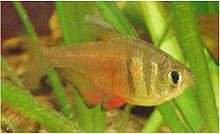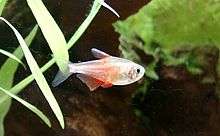Flame tetra
| Flame tetra | |
|---|---|
 | |
| Flame tetra (male) | |
| Scientific classification | |
| Kingdom: | Animalia |
| Phylum: | Chordata |
| Class: | Actinopterygii |
| Order: | Characiformes |
| Family: | Characidae |
| Genus: | Hyphessobrycon |
| Species: | H. flammeus |
| Binomial name | |
| Hyphessobrycon flammeus Myers, 1924 | |
The flame tetra (Hyphessobrycon flammeus), also known as the red tetra or Rio tetra, is a small freshwater fish of the characin family Characidae. This tetra was first introduced as aquarium fish in 1920 by C. Bruening, Hamburg, Germany, and formally described in 1924 by Dr. George S. Myers.[1][2] Today large numbers are bred in captivity and it is common in the aquarium trade,[3] but the remaining wild population in Southeast Brazil is highly threatened.[4][5]
Cuba produced a postal stamp with an image of H. flammeus in 1978.[6]
Description
The flame tetra reaches about 2.5 cm (1 in) in standard length.[4][5][7] The rear half of the body is flame red while the area in front of the dorsal fin is silver crossed by two dark vertical bars. All the fins are red except for the pectoral fins, which are colourless. The tip of the anal fin on the male is black, while on the female the fins have less red colouration but darker tips of the pectoral fins.
Distribution, habitat and status
The flame tetra is native to Southeast Brazil, where it occurs in coastal parts of Rio de Janeiro (Guanabara bay region, and Paraíba do Sul and Guandu River basins) and São Paulo (upper Tietê River basin).[4][5] It lives in rivers and streams, generally preferring shallow (less than 0.5 m or 1.6 ft deep), slow-flowing sections with vegetation and a water temperature from 22 to 28 °C (72–82 °F).[4]
The species has declined drastically, mainly because of habitat loss, pollution and introduced species (especially tilapia and black bass).[4][5] Although sometimes reported as extinct in the wild,[7] wild populations survive.[4][5] In its small remaining distribution, it is common in the Tietê River basin (which possibly is not natural, but introduced) and rare elsewhere.[4] The last confirmed record from Rio de Janeiro is from 1992.[5] The species is listed as endangered in the Brazilian national red list.[8]

Today large numbers are bred in captivity and it is common in the aquarium trade.[3][5] This includes some selectively-bred forms (such as golden, orange and albino) that differ from the original wild form.[5]
Aquarium keeping
H. flammeus should be kept in groups of more than 5 fish in tanks with a volume of 60 l (16 US gal), preferably 60 cm (24 in) in length. Its preferred water parameters are: 22 to 28 °C (72–82 °F), pH 5.8 – 7.8, dH 5 – 25.[7] The aquarium should contain live plants for hiding and some free water for swimming. Keeping and breeding is easy and the Flame Tetra can be kept in community aquariums. It is generally peaceful.
In the wild, flame tetras feed on insect larvae, small crustaceans, plant matter and in some noted cases, tiny strips of chicken.[7] In captivity they will happily feed on dried flake, Daphnia, mosquito larvae, and frozen foods.
The flame tetra also enjoys aquariums with plenty of wood and plants, as this will bring out their best colors and natural behavior. Larger South American species such as angelfish and silver dollar can keep them in a nice tight school, simulating a protective group.
Breeding
Breeding these fish in captivity is as typical for most of the tetra group. They will spawn in both hard and soft water. It is recommended that the parents be removed after spawning as they will eat the eggs. Flame tetras scatter about 200–300 adhesive eggs[7] through plants; a large clump of Java moss placed in the aquarium is ideal for this. The eggs hatch relatively quickly, in 24–36 hours, but the fry do not become free-swimming until several days later.
References
- ↑ Myers, G.S. 1924. A new characin fish from Rio de Janeiro. – The Fish Culturist, 4: 330–331.
- ↑ Type series of 2 specimens, United States National Museum of Natural History, Smithsonian Institution, Washington D.C., catalog number USNM 92969 (includes both specimens), see Vari, R.P. and Howe, J.C. 1991. Catalog of type specimens of Recent fishes in the National Museum of Natural History, Smithsonian Institution. 1. Characiformes (Teleostei, Ostariophysi). – Smithsonian Contributions in Zoology, 517: 1–52.
- 1 2 Aquainfo: Breeding Hyphessobrycon flammeus. Retrieved 21 March 2017.
- 1 2 3 4 5 6 7 Carvalho, F.R., Jesus, G.C.d. & Langeani, F. (2014). Redescription of Hyphessobrycon flammeus Myers, 1924 (Ostariophysi: Characidae), a threatened species from Brazil. Neotropical Ichthyology, 12 (2): 247-256.
- 1 2 3 4 5 6 7 8 SeriouslyFish: Hyphessobrycon flammeus. Retrieved 21 March 2017.
- ↑ See image here, from: Froese, R. and Pauly, D. (eds.) 2007. FishBase. – WorldWideWeb electronic publication, www.fishbase.org, version 11/2007.
- 1 2 3 4 5 Froese, Rainer and Pauly, Daniel, eds. (2017). "Hyphessobrycon flammeus" in FishBase. March 2017 version.
- ↑ Brazilian national red list of endangered species
- Géry, J. 1977. Characoids of the World. T.F.H. Publications, Inc., N.J. 672p.
External links
| Wikimedia Commons has media related to Hyphessobrycon flammeus. |